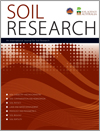Pyrogenic carbon (PyC), the product of incomplete biomass combustion, is a heterogeneous and persistent component of soil organic carbon, but estimating soil PyC at large spatial scales remains a significant challenge. We found lower amounts of PyC in European soils compared to other geographic regions and regional patterns that contrast with estimated PyC production rates. These insights highlight mechanisms that control the accumulation of PyC in soils and will help us improve our predictions of soil PyC at global scales.

Soil Research
Volume 60 Number 2 2022
Soils irrigated with wastewater are generally phosphorus (P)-enriched. To avoid increasing availability and P loss, amendments should consider the initial pH of the soil – matching acid amendments to acidic soils and alkaline amendments to neutral or alkaline soils. However, amendments may only be effective in the short term and are expensive, meaning that other strategies are required to reduce P loss in the long-term.
SR20313Priming of carbon decomposition in 27 dairy grazed soils after bovine urine additions
Soil organic matter (SOM) plays a vital role in carbon storage and bovine urine can enhance priming of carbon decomposition, potentially decreasing soil carbon pools. Urine increased carbon dioxide (CO2) fluxes under laboratory conditions and emissions varied within and between soils and soils exhibited both negative and positive priming. Priming effects of bovine urine were soil specific and not influenced by changes in soil pH, electrical conductivity, or carbon content.
SR20313 Abstract | SR20313 Full Text | SR20313PDF (1.8 MB) | SR20313Supplementary Material (4.9 MB) Open Access Article
SR20223Soil water deficit effects on soil inorganic nitrogen in alternate-furrow flood irrigated Australian cotton production systems
 , Graeme D. Schwenke
, Graeme D. Schwenke  , Annabelle McPherson, Clarence Mercer, Jonathan Baird and Gunasekhar Nachimuthu
, Annabelle McPherson, Clarence Mercer, Jonathan Baird and Gunasekhar Nachimuthu 
The release of plant available nitrogen (N) from organic matter decomposition is important for plant growth. Different irrigation management strategies can affect the decomposition and hence, the amount of N available for plant growth. Estimates of apparent soil N mineralisation can be derived from the measured yields in zero N strips and pre- and post-season soil N measurements at the end of each season.
SR20223 Abstract | SR20223 Full Text | SR20223PDF (897 KB) Open Access Article
Rainfed dairy pasture production is driven by climate conditions across the growing season. Nitrogen (N) fertiliser losses can be large and enhanced-efficiency N fertilisers (EEFs) such as nitrification inhibitors, urease inhibitors and polymer coatings are effective in reducing these losses. Combining EEFs with reduced N rates increases their potential benefit. Whilst agronomic benefits were seen at times with EEFs, seasonal impacts on N losses and pasture production limited the ability to reliably predict achievable benefits from reducing urea N rate combined with use of EEFs.
Understanding the microbial processes of nitrogen (N) cycling and greenhouse gases (N2O) emission during meadow degradation is essential for management of alpine meadow ecosystems. We investigated the microbial communities related to soil N-cycling function, from four meadows along a degradation gradient and found that soil properties, especially N reaction substrates, were the primary drivers for N2O emissions via mediation of nitrification communities. This study provides a new perspective for the underlying mechanisms of biogeochemical cycles in an alpine meadow ecosystem.
SR21148Soil formation, nutrient supply and ecosystem productivity on basaltic lava vs rhyolitic pumice on Alcedo Volcano, Galápagos
 , Tamara C. Dinter, I. Nyoman Candra, Armin Bajraktarevic, Markus Puschenreiter and Martin H. Gerzabek
, Tamara C. Dinter, I. Nyoman Candra, Armin Bajraktarevic, Markus Puschenreiter and Martin H. Gerzabek 
Rock type may strongly affect soil formation and resulting soil properties. We compared two soils formed in close proximity on contrasting volcanic rocks (basalt vs rhyolite) and found strong differences in their organic carbon stocks and nutrient availability with resulting effects on plants and soil microbes. The studied lithologic contrast leads to the development of distinct ecological niches in close proximity.
Salt precipitation on soil surface is common in arid areas. Salt precipitation showed two growth patterns, homogeneous fine powder crystals and discrete and large crystals, observed under high and low evaporation demand conditions, respectively, it resulted in evaporation process with significant differences between the two patterns. We suggested that the physics of the salt crust should be considered as well, in addition to the salt crust cover.
Most soil microorganisms have the ability to colonise plants, creating an association with them and increasing growth and yields. We conclude that the Azospirillum lectins are involved in adaptational changes in wheat seedlings. These lectins’ properties, in combination with the growth-promoting activity of Azospirillum bacteria, are conducive to the development of plant resistance to adverse factors and to increased plant productivity.



